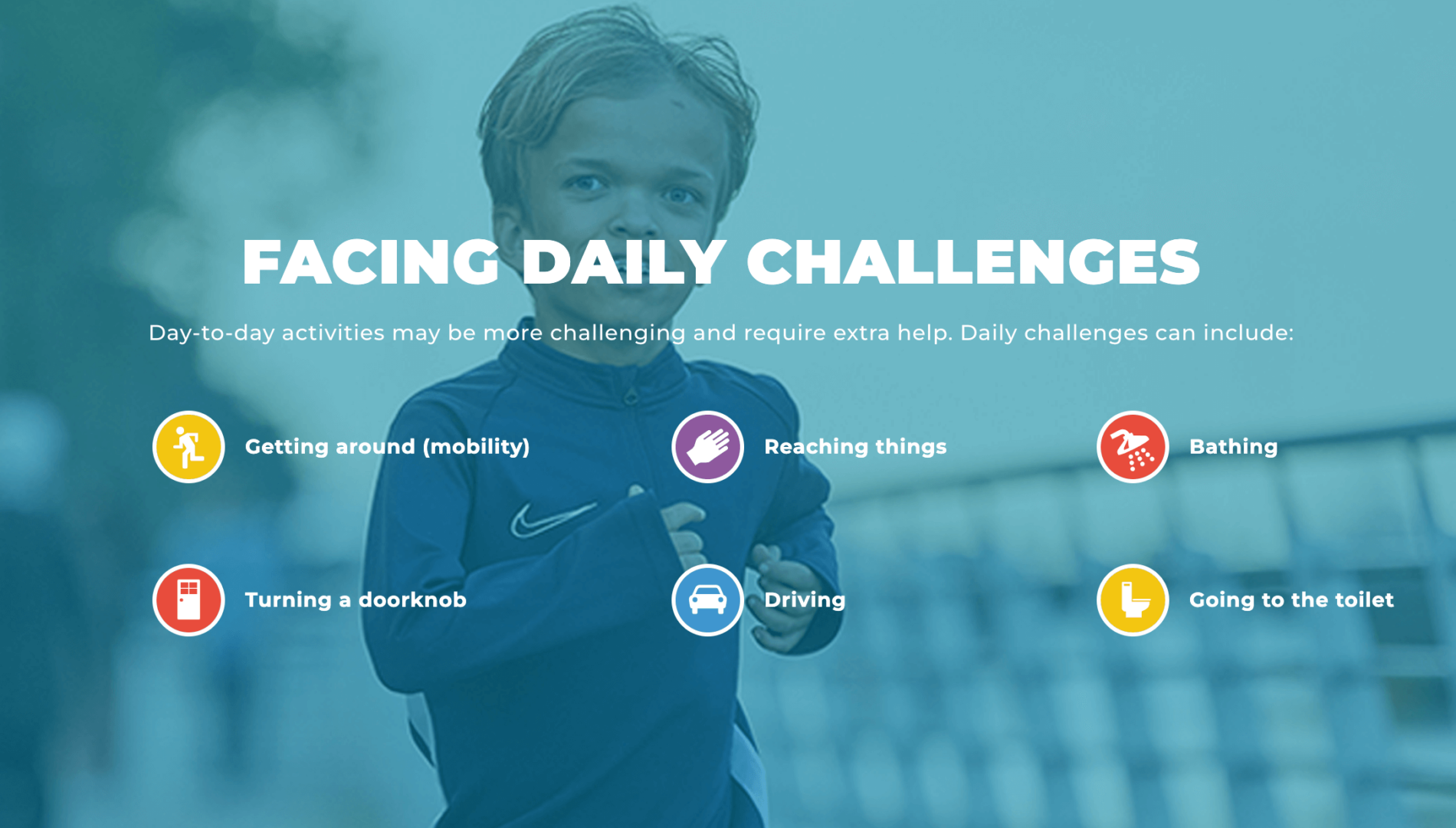Through school, university, work and beyond, people with achondroplasia can lead healthy, active lives. At the same time, because of the way their bones grow, physical complications can occur and progess over time. But if you know what to expect, you can be well prepared for lifelong management of achondroplasia with the help of your care team.
What are the possible complications
You may notice some complications as early as infancy. Some will get better over time. You should watch out for them, but not all of them may need immediate care. Others may not go away on their own and may require medical intervention, even surgeries. It’s important to talk with your doctor to understand when medical care might be needed.
It’s important to know that while achondroplasia may cause physical challenges, your child’s cognitive development is not affected.
Here are some of the more common complications that people with achondroplasia may experience throughout their lives:
Ear infections affect ~68% of children – and frequent ear infections can sometimes lead to hearing loss1
Dental issues, like misaligned teeth, a narrow palate, open bite or underbite2
Kyphosis, a forward bending of the spine – most infants will develop this complication, but it usually corrects itself as they grow2
Elbow stiffness, which often limits their ability to fully straighten their arms2
Bowed legs, which can affect walking and running, and may need surgery to manage2
Sleep apnoea is a disorder where breathing repeatedly stops and starts during sleep; it affects ~50% of people with achondroplasia3
Obesity, high blood pressure, heart disease2
Back and leg pain2
Infancy is an exciting time for new parents. It’s also an important time to watch for complications. In the first year of life, an infant with achondroplasia may need extra attention and closer medical supervision. In the early months of infancy, the healthcare team may monitor for neurological and respiratory complications. Your child’s healthcare team will be watching for additional complications.

Squeezing of the spinal cord where the skull meets the spine (cranio-cervical junction constriction). Surgical intervention is needed in 2-3% of patients1
Low muscle tone1
Delayed milestones, such as rolling over and sitting up 2
Breathing problems caused by the way the bones in the face grow (midface hypoplasia) and, sometimes, small chest size and smaller lung volume1
Sleep apnoea, a disorder where breathing repeatedly stops and starts during sleep1
Buildup of fluid on the brain (hydrocephalus). In rare cases (3-5%), a surgical procedure is needed to treat this complication1
It may take a bit longer, but developmental milestones will happen. Your child will likely achieve them in their own time. Remember, every child’s journey will be at a different pace.
Be sure to ask your doctor about any concerns you have about your child’s development. Remember: achondroplasia does not affect your child’s cognitive development.

Delayed speech, likely due to hearing loss1
Delayed walking due to the way your child’s bones grow1
“Sway back” (an inward curving of the lower back). This is common in most children with achondroplasia1
Leg bowing (genum varum), which affects between a third and half of children with achondroplasia1
Emotions. Peer pressure. The need to fit in. The teenage years are difficult for everyone. But for a teenager with achondroplasia, this time of life can be even harder. Feelings of depression, anxiety and isolation are common, so support is critical during these years.
Remember, your child’s intelligence is not affected by achondroplasia, so it’s important to speak with them at the appropriate level for a teenager.

Psychosocial challenges1
Spinal stenosis (pressure on the spinal cord and nerves in the spine), which can cause leg weakness, clumsiness, trouble walking, and incontinence (loss of bladder control), and may require surgery2,3
As your child becomes an adult, they may outgrow some complications, while others may continue. And new complications may arise that they haven’t experienced before. Mobility and pain can continue to be challenging, affecting work, physical activity, and even daily household responsibilities.
Learning what to expect today can help your child be better prepared to handle these challenges tomorrow.

Spinal stenosis (pressure on the spinal cord and nerves in the spine), which can cause leg weakness, clumsiness, trouble walking, and incontinence (loss of bladder control), and may require surgery1,2
Increased risk for heart disease, which can shorten life span2

The opportunity to conceive and have children is no different for women with achondroplasia than for those of average height. But because of the smaller size of their pelvises, women with achondroplasia are advised to deliver by caesarean section.It’s also important to remember that achondroplasia is genetic condition. This means that it can be passed down to children. Speaking with a geneticist can help offer guidance on family planning.

Growing up can be hard, both socially and emotionally. Kids with achondroplasia may have challenges with self-esteem, social pressure and anxiety.
– Caregiver of a child with achondroplasia
Links to sites outside of this website are provided as a resource to the viewer. BioMarin accepts no responsibility for the content of linked sites.